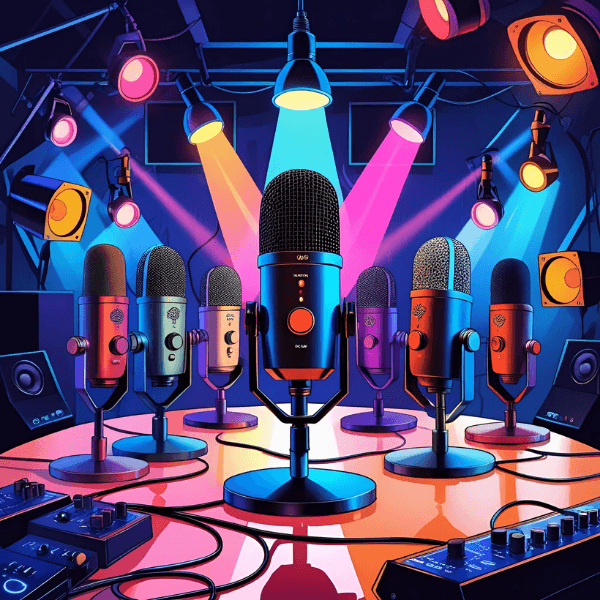
USB microphones for streaming and podcasting – Capture crystal-clear audio for your streams and podcasts with the best USB microphones of 2025. Discover our top picks for easy setup, professional sound, and reliable performance.
In the rapidly expanding world of online content creation, crystal-clear audio is no longer a luxury – it’s a necessity. Whether you’re a seasoned Twitch streamer, a budding podcaster, a YouTube content creator, or someone who just wants to sound great on video calls, a high-quality microphone is your most valuable tool. While XLR microphones offer ultimate flexibility, USB microphones provide an unparalleled level of convenience: simply plug into your computer, and you’re ready to record or go live.
In 2025, the USB microphone market is more competitive and innovative than ever, offering professional-grade sound, intuitive features, and robust build quality that cater specifically to streamers and podcasters. You no longer need a complex audio interface to get fantastic results.
This guide delves into The Best USB Microphones for Streaming and Podcasting: Our Top Picks. We’ve selected models that stand out for their sound quality, ease of use, features tailored for content creation, and overall value, ensuring you find the perfect mic to elevate your audio.
What to Look For in a USB Microphone for Streaming and Podcasting

Choosing the right USB microphone can significantly impact your audio quality. Here are the key factors to consider:
- Sound Quality: This is paramount. Look for microphones that capture a clear, natural, and rich vocal tone.
- Dynamic vs. Condenser:
- Condenser Mics: Generally more sensitive, capturing a wider frequency range and more detail. Best for quiet, acoustically treated rooms where they can pick up all the nuances of your voice.
- Dynamic Mics: Less sensitive, excellent at rejecting background noise and handling loud sounds (like enthusiastic yelling during gaming). Ideal for untreated rooms or noisy environments. Many hybrid USB/XLR mics are dynamic.
- Dynamic vs. Condenser:
- Polar Patterns: This determines how the microphone picks up sound.
- Cardioid: The most common and recommended pattern for streaming/podcasting. It picks up sound primarily from the front, rejecting noise from the sides and rear, making your voice stand out.
- Omnidirectional: Picks up sound from all directions. Useful for group discussions around a single mic.
- Bidirectional (Figure-8): Picks up sound from the front and back, rejecting sides. Good for two-person interviews facing each other.
- Stereo: Uses two capsules to create a stereo image.
- Some versatile mics offer multiple switchable patterns.
- Built-in Features & Controls:
- Headphone Jack (Zero-Latency Monitoring): Essential! Allows you to hear your voice in real-time, preventing awkward delays (latency) and helping you monitor your levels.
- Gain Control: A knob on the mic to adjust input sensitivity, preventing distortion (clipping) or ensuring your voice is loud enough.
- Mute Button: Crucial for quick muting during live streams or recordings.
- Mix Control: Allows you to balance the sound of your voice with your computer’s audio in your headphones.
- Build Quality & Mount:
- Durability: A sturdy metal construction is preferable for longevity.
- Integrated Stand/Mount: Many come with a desk stand, but consider if it’s stable. A built-in shock mount helps reduce vibrations.
- Boom Arm Compatibility: Most good USB mics are designed to be mounted on a boom arm for optimal positioning, which can significantly improve sound quality by getting the mic closer to your mouth.
- Software/App Integration: Some mics come with companion software for advanced controls like EQ, noise gates, compressors, and auto-gain features, simplifying your audio workflow.
- Connectivity: While primarily USB (USB-A or USB-C), some advanced models offer dual USB and XLR connectivity, providing a pathway for future upgrades to an audio interface.
Our Top Picks: The Best USB Microphones for Streaming and Podcasting

1. Shure MV7 / MV7+
- Why it’s here: Often called the “podcast mic for the rest of us,” the Shure MV7 (and its enhanced MV7+) combines both USB and XLR connectivity, giving you flexibility now and for future upgrades. It’s a dynamic microphone, excelling at capturing clear vocals while rejecting background noise. Shure’s MOTIV software offers powerful DSP features like Auto Level Mode, EQ, and a noise reduction, making it incredibly easy to get a professional sound without deep audio knowledge.
- Ideal for: Podcasters, streamers, and musicians who want professional-grade audio with smart features and the flexibility of both USB and XLR.
2. Rode NT-USB+
- Why it’s here: The NT-USB+ is a premium condenser USB microphone known for its studio-grade sound quality. It delivers a warm, clear, and detailed audio capture. The inclusion of Rode’s Revolution Preamp ensures ultra-low noise, and built-in APHEX audio processing (accessible via Rode Connect software) provides advanced voice enhancement. It comes with a pop filter and a desktop tripod, making it ready to go out of the box.
- Ideal for: Users in quiet, controlled environments who prioritize pristine vocal clarity and detailed audio for podcasts, voiceovers, and singing.
3. Blue Yeti / Yeti X
- Why it’s here: The Blue Yeti series remains incredibly popular for its versatility and ease of use. With multiple polar patterns (cardioid, omnidirectional, bidirectional, stereo), the Yeti can adapt to almost any recording scenario (solo streaming, interviews, group podcasts). The Yeti X offers enhanced sound quality, a high-res LED meter, and more granular controls. They are plug-and-play and often found at accessible price points.
- Ideal for: Beginners, versatile content creators needing multiple polar patterns, and those seeking a reliable, all-in-one desktop solution.
4. Elgato Wave:3
- Why it’s here: Designed specifically with streamers in mind, the Elgato Wave:3 integrates seamlessly with streaming setups. Its standout feature is Clipguard technology, which automatically prevents audio clipping. Paired with the powerful Wave Link software, you get a virtual mixer allowing you to manage multiple audio sources (game audio, music, mic, etc.) with ease. It’s a condenser mic, providing clear and clean audio.
- Ideal for: Live streamers, gamers, and content creators who need robust software integration, anti-clipping technology, and streamlined audio mixing.
5. HyperX QuadCast S
- Why it’s here: A visual standout, the QuadCast S offers vibrant RGB lighting alongside great audio performance. It features four selectable polar patterns, a built-in pop filter, and a tap-to-mute sensor with an LED indicator. Its integrated anti-vibration shock mount helps reduce unwanted rumbles.
- Ideal for: Gamers and streamers who want excellent audio with visual flair and versatile pattern options. For competitive gaming, also check out our list of 5 Best Gaming Headsets Under $100: Dominate Without Breaking the Bank.
6. Audio-Technica ATR2100x-USB
- Why it’s here: A fantastic dual-connectivity dynamic microphone that offers both USB-C and XLR outputs. The ATR2100x-USB provides clear, articulate vocal reproduction and excellent off-axis rejection (meaning it rejects sounds from the sides/back), making it great for untreated rooms. It’s durable, comes with a basic desktop stand, and includes a headphone jack.
- Ideal for: Budget-conscious podcasters and streamers who want the benefits of a dynamic mic and the option to upgrade to an XLR setup later.
7. Rode PodMic USB
- Why it’s here: The iconic PodMic, known for its broadcast-quality dynamic sound, now comes with a USB-C output! The PodMic USB offers that rich, warm, and clear vocal tone often associated with professional radio. Its robust build and internal pop filter make it highly durable and great at minimizing plosives.
- Ideal for: Podcasters seeking a classic broadcast sound in a convenient USB format, or those who appreciate rugged build quality.
8. Maono PD300X
- Why it’s here: A surprisingly capable dynamic USB/XLR microphone that punches above its weight class in terms of sound quality. It offers a clear and full sound, good noise rejection, and comes with companion software for EQ and gain control. It’s a strong contender for budget-conscious users who want both USB and XLR.
- Ideal for: Users looking for a versatile and high-performing dynamic mic at a very competitive price.
Elevate Your Audio, Elevate Your Content

Choosing the right USB microphone is a significant step towards producing high-quality streams and podcasts. These top picks offer a range of features and sound profiles, ensuring there’s a perfect match for your specific needs and budget. From the versatile Shure MV7 to the studio-grade Rode NT-USB+, you can achieve professional-sounding audio with the simplicity of a USB connection.
Remember, proper mic technique (getting the mic close to your mouth, speaking clearly) and understanding your room’s acoustics can make even a good mic sound great. Invest in your audio, and watch your content thrive!
Related Links

Internal Guides & Reviews from Gear For Audio:
- 5 Best Gaming Headsets Under $100: Dominate Without Breaking the Bank
- The 12 Best Studio Monitor Speakers for Home Recording in 2025
- What’s the Difference Between Open-Back and Closed-Back Headphones?
- Top 8 Budget Audiophile Headphones That Sound Like a Million Bucks
External Resources for Deeper Dive:
- MusicRadar – Best podcasting microphones 2025: our expert picks for every budget and level (DoFollow – A highly respected source for in-depth audio equipment reviews, including many microphones suitable for podcasting.)
✅ FAQ – USB Microphones for Streaming and Podcasting

1. What are the best USB microphones for streaming and podcasting in 2025?
Some of the top-rated USB microphones for streaming and podcasting in 2025 include the Blue Yeti, Elgato Wave:3, and Audio-Technica ATR2500x. These offer great audio quality, plug-and-play convenience, and are ideal for content creators.
2. Are USB microphones good for podcasting?
Yes, USB microphones for podcasting are perfect for beginners and intermediate podcasters. They’re easy to use, affordable, and don’t require additional audio interfaces or complex setups.
3. What’s the difference between USB and XLR microphones?
USB mics plug directly into your computer and are ideal for simplicity. XLR microphones offer higher fidelity and flexibility but require an audio interface. For most streamers and podcasters, USB is the go-to choice for ease and affordability.
4. Do I need an audio interface for a USB mic?
No, one of the main advantages of using USB microphones for streaming is that they don’t require an audio interface. They connect directly to your computer via USB.
5. What features should I look for in a USB microphone?
Look for key features such as cardioid pickup pattern, gain control, mute button, headphone output for monitoring, and compatibility with popular platforms like OBS and Zoom.
6. Are there affordable USB microphones that still offer great quality?
Yes! Some of the best affordable USB microphones include the Fifine K669B, Samson Q2U, and Razer Seiren Mini. These mics provide high-quality sound on a budget.


Pingback: Eliminate Echo Reverb Home Recording - Learn To Eliminate Echo & Reverb At Home (2025)
Pingback: Ultimate Best Noise Cancelling Earbuds 2025: Travel & Commute In Peace